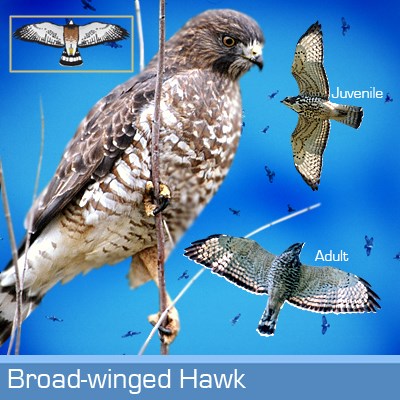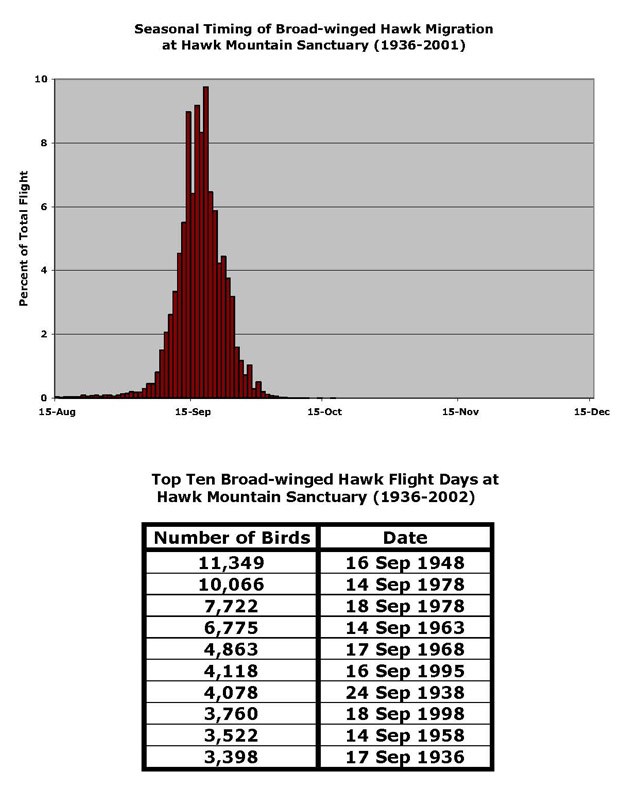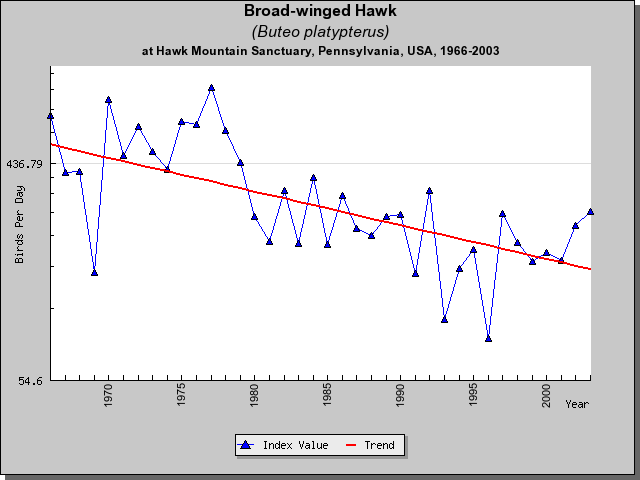Broad-winged Hawks are Hawk Mountain's most numerous species.

Buteo platypterus
67-year annual average: 8,164
1992-2001: 6,400
Record year: 29,519 (1978)
Best chance to see: Mid-September.
Longterm trends: Increased in 1950s, 1960s, and early 1970s; decreasing since the late 1970s.
A.K.A. Broadwing
Field marks: Stout, compact buteo, with broad, pointed wings, and short tail. Adults are barred rufous on the chest, with a conspicuous white tail band. Juveniles are white underneath with dark streaking on the sides of the belly, with a gray-brown striped tail
Flight behavior: Almost always migrates in small flocks to several thousand birds. Soars extensively, especially in thermals. Most broadwings pass by the Sanctuary within a single week in mid-September.
What Size is a Broad-winged Hawk?
- Wingspan2'8"-3'
- Length13"-17"
- W-L ratio2.3:1
- Weigth15-17 oz.
Raptor Bites
- Broad-winged Hawks are part of the family Accipitridae, which includes 224 species of hawks, eagles, vultures, harriers, and kites.
- Broad-winged Hawks are named for their short, broad wings.
- Broad-winged Hawks are the smallest buteos in Eastern North America.
- Populations of Broad-winged Hawks appear to be expanding westward, especially in Canada.
- Broad-winged Hawks are one of the most migratory buteos in North America.
- Broad-winged Hawks are long distance migrants, many of which breed in Canada and winter in Brazil.
- On migration, Broad-winged Hawks travel in flocks of hundreds and sometimes thousands, of birds.
- Broad-winged Hawks conserve energy on migration by soaring on thermals and mountain updrafts.
- Unlike some raptors, Broad-winged Hawks build new nests every year.
Seasonal Count – from North Lookout – 1934 to Date
Introduction
The Broad-winged Hawk is the smallest and most migratory Buteo in eastern North America. This stout, compact, forest-dwelling raptor occurs in most of the forested landscapes of the eastern United States and southern Canada east of British Columbia. The species is a complete, long-distance migrant that winters in Central and South America. Unlike most other North American raptors, broadwings flock during migration, and in autumn the majority of individuals pass migration watchsites during a brief and concentrated two-week period. At the peak of their spring and fall migrations, flocks or “kettles” of tens of thousands of Broad-winged Hawks can be seen along the shorelines of the Great Lakes, as well as from southern Texas through Central America. Non-migratory subspecies of broadwings inhabit Cuba, Puerto Rico, and several other islands in the West Indies.
Identification
Although the Broad-winged Hawk is named for its broad wings, it is the bird’s conspicuously banded tail that provides its most distinctive field mark. Adult Broadwinged Hawks are brownish above and barred rufous below. The blackish-brown tail of adults has one especially conspicuous broad white band, and a second narrower and less conspicuous one. Juveniles, which appear similar to adults from above, are whitish with brown streaking below, and have light brown tails with four to five dark brown bands. The underwing of both age classes is whitish with a dark band along the trailing edge. The extremely rare dark morph Broad-winged Hawk is generally blackish throughout. Broadwings can be distinguished from other species of Buteos by their smaller size, compact configuration, and more pointed wings.
Breeding Habits
During the breeding season, broadwings are secretive, and often go undetected. Territorial adults are sometimes seen circling above the canopy, whistling their characteristic peee-uurr, but broadwings mostly remain within the canopy where they spend much of their time hunting from perches. Both the male and the female help build the nest, which is usually placed in the crotch of the main trunk of deciduous and less frequently, coniferous trees. Broadwings construct smallish (30- 50 cm wide, up to 25 cm deep) and relatively crude stick nests, which are lined with fresh deciduous twigs while the female begins laying eggs. Female broadwings usually lay two or three eggs and do most, if not all, of the incubation and brooding. Chicks hatch after 28 to 31 days, and then fledge 29 to 31 days later. Within a week or so of fledging, juveniles intercept their parents for food when the parents attempt to return to the nest to feed their young. Siblings, especially in larger broods, frequently fight among themselves for access to their parents at such times.
Feeding Habits
Broadwings are inconspicuous, perch-hunting, generalist predators that feed largely on small mammals, birds, amphibians, reptiles and invertebrates. Forest edges serve as important hunting areas for this species. Individuals rarely stoop on or pursue their prey for great distances. During migration, broadwings will feed opportunistically on insects, including migrating dragonflies, and on migrating songbirds. This species does not acquire large stores of fat prior to migration and depends upon soaring to complete its long-distance journeys.
Migration

The Broad-winged Hawk is one of only five North American raptors that are complete migrants. All continental populations of broadwings are migratory, the five West Indian subspecies are sedentary. Most Broad-winged Hawks breeding in the eastern United States and southeastern Canada migrate to wintering grounds in southern Central America and central South America. A small portion of the population, consisting mainly of juveniles, winters in Florida, coastal Texas, and in the lower Mississippi Delta. Little is known regarding the habitats used by broadwings during migration, but they appear to roost only in wooded areas. On their wintering grounds in Central and South America, Broad-winged Hawks inhabit a range of woodland types including mature tropical forests, second-growth forests, forest edges, and associated clearings.
To reduce the energy costs associated with long distance migration, this migrant capitalizes on favorable atmospheric conditions such as mountain updrafts and thermals for soaring. By allowing themselves to be drifted by prevailing winds, migrating broadwings are able to reduce energy costs and fly faster. Even so migrants need to balance between the energy-saving benefits of flying in the direction of the prevailing winds, while still maintaining a direct path to their destination. At the beginning of their migration, migrants make less of an effort to correct for wind drift, but as they get closer to their destination compensatory movements increase. Prevailing wind conditions in eastern North America push southbound birds to the south and east of their return routes in the spring, creating an elliptical migration route. Thus, watchsites along the Atlantic coast and the Kittatinny Ridge in eastern Pennsylvania observe far fewer broadwings in the spring than in the fall. In the spring, large counts are observed at inland sites, such as those on Lake Ontario, including Derby Hill, New York and Braddock Bay, New York.
Broad-winged Hawks often soar in thermals and mountain updrafts. Like other raptors, Broad-winged Hawks begin their migration as broad-frontal migrants but then concentrate along leading lines. Soaring migrants like Broad-winged Hawks avoid large water crossings. Favorable landscape features that concentrate migrants include ridges where conditions are suitable for slope soaring, and manmade features such as cities where strong thermals form. Since thermal soaring functions as their primary migration strategy, Broad-winged Hawks do not exhibit strong ridge adherence.
Unlike most North American raptors, broadwings migrate in large flocks called “kettles,” that range in size from several birds to thousands of individuals. Only a small percentage of broadwings migrate alone. Broadwings are not particularly social, but flocking increases their ability to find thermals and mountain updrafts. For Broad-winged Hawks one of the best means of locating thermals is by following another Broad-winged Hawk. In addition to facilitating an individual’s ability to efficiently find thermals, flocking is also believed to aid in orientation and navigation. Observations at Hawk Mountain Sanctuary indicate that adult Broad-winged Hawks are more likely to flock than are juveniles, and that in mixed-aged flocks adults are more likely to be the leading bird or in the leading half of the flock. By flocking and following more experienced adults, juveniles maximize the extent to which they take advantage of favorable atmospheric conditions and reduce the extent to which they fly off course. Observations of juveniles wintering in Florida, a location off the migration route and north of the typical wintering grounds, appears to support the idea that juveniles are more likely than adults to have difficulty with navigation and orientation.
The need to migrate using thermals also plays a role in the timing of Broad-winged Hawk migration. The Broad-winged Hawk is one of the first migrants to leave their breeding grounds in the fall and one of the last to return in the spring. In autumn at Hawk Mountain, 95% of the migrating Broad-winged Hawks sighted pass through during a two-week period in mid-September. In the past, researchers attributed the Broad-winged Hawk’s early departure from its breeding ground to the long distance they need to travel to their wintering grounds or to the reduced availability of their preferred prey on their breeding grounds. Analysis of 60 years of Hawk Mountain Sanctuary data suggests that the timing and concentration of Broad-winged Hawk migration are neither a consequence of long distance movements nor food availability. Rather, the early and compressed fall migration is a result of the Broadwinged Hawk’s dependence on thermals. Broad-winged Hawks need to leave their nesting grounds as soon as possible in order to migrate when thermal activity is most predictable. Birds that leave later in the season, when the days are shorter and the sun is not as high in the sky, will face conditions that are less favorable for thermal migration. When thermal production is reduced, migrants must resort to powered flight to a greater extent, an energetically costly and undesirable alternative. Their hurried departure from North America in mid- to late September enables them to avoid such problems.
Conservation Status

The current “world” population of this Western Hemisphere species is thought to be approximately 1.5 to 2 million birds. There is little evidence that broadwings were substantially affected by the widespread use of organochlorines during the 20th century. Currently, at least some mainland, and many Caribbean populations are threatened by the loss of large stands of contiguous forest. Counts at Hawk Mountain Sanctuary have been lower in recent years than they were earlier, possibly because the species has changed its principal migration route in the region. Broadwings appear to be expanding their breeding range westward, especially in Canada.
| BWHA Trends | ||
| Year Range | Trend Value | P |
| 1970-1980 | -3.1 | <0.0001 |
| 1974-2004 | -3.1 | <0.0001 |
| 1980-1990 | -3.1 | <0.0001 |
Bent, A.C. 1937-1938. Life histories of North American birds of prey. (vol.1-2). New York: Dover.
Bildstein, K.L. 1998. Racing with the sun: the forced migration of the broad-winged hawk. In Gatherings of Angels: the Ecology and Conservation of Migrating Birds. (K. P.Able, ed.). Ithaca: Cornell University Press.
Brauning, D.W. 1992. Atlas of breeding birds in Pennsylvania. Pittsburgh: University of Pittsburgh Press.
Brown, L., & Amadon, D. 1968. Eagles, hawks, and falcons of the world. New York: McGraw-Hill.
Dunne, P. 1995. The wind masters. Boston: Houghton Mifflin.
Goodrich, L.J., Crocoll, S.C., & Senner, S.E. 1996. Broad-winged hawk (Buteo platypterus). In The birds of North America, No. 218 ( A. Poole and F. Gill, eds.). The Academy of Natural Sciences, Philadelphia, PA; and The American Ornithologists’ Union, Washington, DC.
Johnsgard, P. 1990. Hawks, eagles, and falcons of North America. Washington DC: Smithsonian Institute Press.
Field Identification
Clark, W.S., & Wheeler, B.K. 1987. A field guide to hawks of North America. Boston: Houghton Mifflin.
Clark, W.S. & Wheeler, B.K. 1995. A photographic guide to North American raptors. San Diego: Academic Press.
Dunne, P., Sibley, D., & Sutton, C. 1988. Hawks in flight. Boston: Houghton Mifflin.